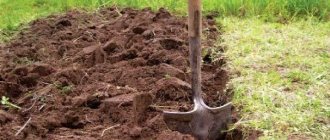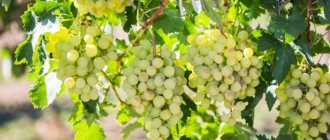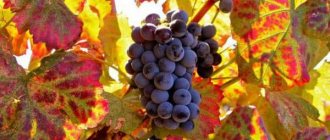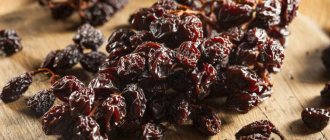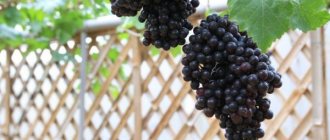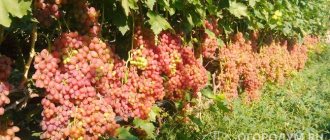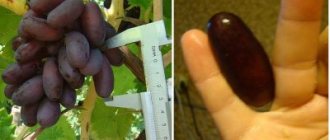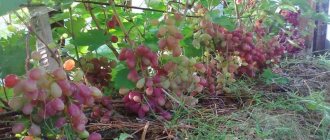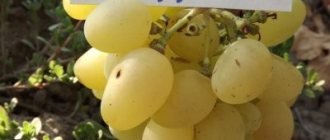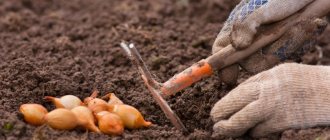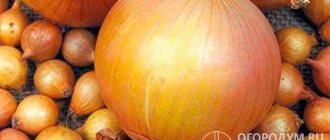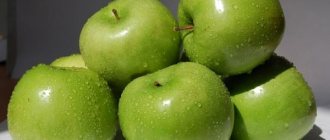Advantages and disadvantages
Like other grape varieties, “alpha” has both positive and negative characteristics.
The undoubted advantages of the variety are:
- Good yield and pollination.
- Frost resistance.
- Disease resistance.
- High vigor, rooting and survival rate.
Also, the “alpha” variety can be used in landscape design, to decorate gazebos, arches, balconies, loggias, etc.
The variety has few disadvantages. Among them are the tendency of bushes to thicken, peas in the absence of timely pruning, low taste of fruits, as well as the need for constant pinching.
Rules of care
The set of measures for caring for the vine includes organizing irrigation of grape plantations, preventing diseases, applying fertilizers if necessary, mulching, tying and pruning the bush.
Watering
It is important to provide the plant with the necessary moisture in the first year after planting. The plant develops a root system and a future vine. The grapes should be watered at the roots with warm water in the evening or early in the morning. An adult vine needs up to 30 liters of water per watering.
It is important to provide the plant with the necessary moisture in the spring, immediately after cleaning the shelter. After watering, the root space is loosened and mulched.
Top dressing
Fertilizing is an important stage in plant care. In the period from April to June, the grapes must be watered abundantly; it is advisable to apply a complex of specialized liquid mineral fertilizers. From available means, use an infusion of bird droppings or cow dung, a mixture of humus, wood ash and sand.
Mulching
To maintain optimal moisture levels, it is important to mulch the root space. The remnants of mown grass or mowed lawn, sawdust, and straw are used as mulch. The mulching procedure is carried out after watering and loosening.
Garter
From the moment of planting, the plant needs support. The grapes are tied to pegs, walls and other surfaces. Alpha grapes form a powerful spreading vine that needs staking and additional support. This variety of grapes is used to create hedges, landscape gazebos and fences.
Disease Prevention
Genetically, the Alpha variety is resistant to most types of fungal and viral diseases, but with improper care, outbreaks of infections can occur, so it is recommended to take preventive measures against grape diseases.
Chlorosis
Occurs when photosynthesis processes in the leaves of a plant are disrupted. The leaf blades begin to sharply fall off and turn yellow. The growth rate of grapes is noticeably reduced, new shoots are not formed, flowers and buds die off. If you do not take measures to save the bush, the grapes die by the beginning of autumn.
If there are signs of chlorosis, it is necessary to take measures to save the vine as a matter of urgency. First of all, it is necessary to review the composition of the soil and add a drainage system. Excess organic matter in the form of fresh manure on alkaline soils can also cause a serious disease. It is necessary to remove excess lime components from the soil.
Gardeners treat chlorosis with iron sulfate and feeding plants with manganese and zinc.
Oidium
Another name for the disease is powdery mildew. An outbreak of the disease most often occurs in the spring. The leaves on the vine do not bloom, and a grayish coating appears on the stems and leaf blades. The formed inflorescences take on the appearance of twigs sprinkled with flour. The fungus can quickly spread to other plants, and the grape harvest can be destroyed.
To combat the disease, preventive spraying of plantings with chemicals is carried out: “Horus”, “Skor”, “Azofos”. In the fall, before hibernation, the vine is treated with copper sulfate.
Rot
White and gray rot are the main fungal diseases affecting grape plantations. The quality of the crop is significantly reduced. Ripe berries dry out, burst, and acquire an unpleasant taste and aroma. Such berries are not suitable for storage and transportation. The main factor causing the disease is cold summers with few sunny days and lots of rain.
For early diagnosis of the disease, plants are sprayed with Bordeaux mixture. When the infection develops strongly, use “Switch”, copper sulfate, “Ronilan”.
Anthracnose
Vague brown spots form on the leaves, which later spread to the stems and berries. The process of fruit rotting begins. Chemical preparations containing copper enter the fight against infection. Among biological preparations, Gaupsin is used.
See also
Description of 30 grape varieties for Siberia, planting and care for beginners
Read
Bird protection
Often the amount of grape harvest is reduced due to the invasion of feathered pests. In this case, rustling repellers or scarecrows are placed next to the plantings. Birds will not dare to get close to the delicious juicy berries.
Methods of protection against pests
Grapes are susceptible to attack by insect pests that want to feast on the succulent foliage of plants or ripe fruits.
Grape flea beetle
A small insect that feeds on the foliage of grapevines. In early spring, the pest begins to eat delicious leaves. Then the adult lays eggs on the inside of the leaf blades, from which voracious larvae hatch. Affected grapes should be sprayed with Karbofos.
Komarik
The pest is common in the south. Lays eggs on the inside of the leaf, the shoots are covered with a fluffy coating. The larvae eat buds, flowers, leaves and even plant stems. Crop losses can reach 50%. The popular way to fight the grape mosquito is to use ichneumon beetles that eat the larvae. In case of severe infestation, insecticides are used.
pad
A parasitic insect that feeds on plant juices. The grapes begin to lag significantly in growth, lose foliage, and the vine may die. “Karbofos” and “Izatrin” are used in pest control. One of the popular methods is to plant cryptolemus beetles on grapes.
Wasps
The sweet berries attract wasps, which feast on the sweet pulp of the fruit. The commercial quality of grapes is reduced, the fruits quickly deteriorate and cannot be transported for a long time. The bunches need to be protected. Often, gardeners use personal protection methods, wrapping the bunches with gauze or netting, or using liquid smoke. It is possible to use wasp repellers, for example, with the drug “Sochva”.
Preparing for winter
In order for the grapes to easily survive the winter period, the plant must be prepared. The vine is pruned and shaped, and covered with additional material for the winter.
Trimming and shaping
The bush is pruned at a distance of 8-10 buds. Alpha is prone to overgrowing, so it is necessary to remove all stepsons and additional shoots using pruning shears.
Support
Supports are important for grapes of this variety; the vine can reach a length of 9 meters. As a rule, fences, pegs, walls, nets, and canopies are used as supports. Without the presence of supporting tools, Alpha cannot grow.
Origin
Alpha grapes were developed in the USA as a result of crossing the Labrusca and Riparia varieties. obtained as a result of breeding work is resistant to low temperatures, so it is successfully cultivated in the northern regions. Excellent varieties from the USA also include “Jupiter”, “Cardinal” and “Century”.
Parents of the “alpha” are “Vitis labrusca” and “V. riparia"
Initially, the “alpha” grapes, along with samples of other varieties selected in America, were delivered to Odessa for varietal testing, and then its cuttings ended up at the “Vinogradar” state farm in the Brest region, Belarus, and eventually spread throughout almost all countries of the former USSR.
American grape variety Alpha
Alpha is a popular North American grape variety that is in high demand in northern viticulture areas. The culture was obtained by crossing varieties such as Riparia and Labrusca. It belongs to the group of industrial crops and has medium ripening periods. Alpha is a variety resistant to frost and the influence of negative external factors that can easily winter without shelter. Outwardly, its berries are similar to Isabella, but they have a much more refined, rich taste and ripen sweeter and juicier. Read more about the characteristics of Alpha grapes and the requirements for their cultivation in this review.
Main characteristics
Reference! "Alpha" is a technical grape variety characterized by high yield. With proper care, one bush can harvest 10-14 kg of berries, the average yield of the variety is 150-180 c/ha.
Maturation period and class
“Alpha” refers to late-ripening grape varieties - approximately 140-150 days pass from the moment the buds open until the fruits fully ripen. Harvesting occurs at the end of September-beginning of October. It is also worth noting other late varieties, such as Merlot, Isabella and Lydia.
Bush
Alpha grapes are powerful, vigorous bushes , prone to overgrowing and thickening due to the presence of a large number of stepsons.
The dense vine, reaching 9 m in length, bears bright green, three-lobed, large (25 cm long and 30 cm wide) leaves with characteristic sharp teeth along the edges.
The flowering period occurs in mid-June, when several bisexual inflorescences form on the shoots.
Bunches and berries
The cylindrical clusters formed after flowering have an average density. As a rule, they are small and weigh on average 150-180 g, but sometimes the formation of larger brushes, weighing about 250 g, is observed.
The berries are round in shape, weigh 2-3 g each, covered with a dark blue thick skin with a fairly dense waxy coating that protects the fruit from damage during transportation.
The pulp is dense, slimy and juicy, there are 2-3 seeds inside. The fruits contain 15-18% sugar and 10-13 g/l acid.
Taste
The taste is dominated by pronounced sourness, a slight aftertaste of strawberries and a light nutmeg aftertaste are also felt.
Why is Alpha interesting?
With good care, you can get such a harvest.
First of all, Alpha attracts winegrowers in regions where cold weather sets in early, since it has an average ripening period, the clusters have time to fill with juice and gain full flavor. When grown in the Siberian region, these grapes are classified as varieties with a medium-late ripening period. It is resistant to winter frosts. The undoubted advantage of Alpha is its immunity to fungal diseases of grapes.
Alpha bushes are vigorous; when growing a variety for harvesting, the vine must be shaped like any grape. Then the berries ripen earlier, the clusters are formed larger and more dense than on unformed bushes. The vine shoots of this variety are long, but ripen well. The bushes become very thick during the growing season and require pruning of the shoots 2-3 times per season.
Alpha's flowers are bisexual, it pollinates well regardless of the weather and forms medium-sized cylindrical clusters, which sometimes have small wings or converge into a cone at the bottom. The clusters are more or less dense, but on unformed vines they become loose. This grape is an excellent pollinator for other varieties, which contributes to their productivity.
Alpha grapes are medium-sized and almost round. When ripe, they become black with a purple or reddish-brown tint. They are covered with a bluish waxy coating. The slimy pulp of the berries is juicy, has a bright isabella flavor, but is sour.
Features of cultivation
Proper care and compliance with the rules of growing grapes is the key to obtaining a high-quality and abundant harvest.
Trimming
The bushes should be thinned throughout the summer, since excessive thickening leads to peas in the berries. You also need to shorten the shoots and remove leaves that block sunlight from reaching the bunches.
The main pruning of the vine into 8-10 buds should be carried out in early November, gradually preparing the grapes for winter.
When decorating gazebos, it is better to use trimming in the form of a vertical forming cordon. Fan formation of bushes is also popular.
Reference! When forming bushes, it is necessary to take into account that usually there are more berries at the bottom, so the shoots should be left on this tier.
Diseases and pests
Among the diseases characteristic of grapes on the “alpha” variety, the development of chlorosis, oidium, varieties of rot, and anthracnose is most often noted.
Speaking of pests, it should be noted that grapes can be susceptible to attack by flea beetles, mosquitoes and cushion worms. Wasps also like ripe fruits.
Frost resistance
“Alpha”, due to its high frost resistance, is classified as a non-covering variety. Depending on the condition and growing conditions, the bushes can tolerate frosts from -30 °C to -35 °C, and the root system can withstand soil freezing down to -12 °C without visible damage.
The “alpha” variety does not require additional shelter and can act as a high-quality rootstock for varieties with low frost resistance.
Harvest storage
Berries should be stored in fruit boxes in a well-ventilated area. During harvesting, it is important not to damage the waxy coating covering the berries, which protects the ripe fruit. Provided that calibration is carried out and damaged and overripe fruits are removed, the harvest can be stored for quite a long time.
The variety is suitable for cultivation in northern, middle latitudes and the Moscow region.
Description of Alpha grapes
Thanks to the efforts of breeding scientists, this variety can be grown not only in the south, but also in the center of Russia.
Of great importance for winegrowers is the size of the fruits and clusters, yield, necessary care, application, and taste.
Parameters of bush, brushes, berries
The bush of this variety is powerful. During growth, stepsons appear, the presence of which is undesirable. The trunk length can sometimes reach nine meters. The leaves are rough, have a rich green color in front, and bright green in the back.
The brushes are small. Their length does not exceed twenty centimeters and their width – fifteen. The weight with proper care is one hundred fifty to two hundred grams.
The berries are small, spherical in shape, covered with a waxy layer, dark blue in color. They hold tightly and do not fall off. They are very attractive to wasps, so it is worth taking care of timely harvesting.
Taste
Alpha is not a table variety. Therefore, his taste is a little tight. It is sweet and sour, with a pronounced sourness. They have a nutmeg flavor. Sugar content is sixteen percent. The acidity is ten to eleven grams per liter.
Application
Experienced winegrowers claim that this technical type can be used to make excellent homemade wine. It will be dark in color, have a pleasant aroma and a slightly tart taste.
Alpha is used to pollinate other varieties.
And it’s a no-brainer that it simply doesn’t make sense to grow this cultivar on an industrial scale.
Productivity
This type is late maturing. The fruits ripen in one hundred ten to one hundred and forty-five days (second half of September).
If you follow all the rules of care, the harvest from one bush will be ten to fourteen kilograms.
Comparison with analogues
Let’s compare “alpha” with several varieties similar to it.
| Sign | Variety | |||
| Alpha | Isabel | Northern Saperavi | Livadia black | |
| Ripening period | 110-145 days | 145-165 days | 140-145 days | 120-130 days |
| Frost resistance | Up to -35 °C | Up to -30 °C | Up to -23 °C | Up to -26 °C |
| Yield per bush | 150-180 c/ha | 50 kg. | 70-110 kg. | up to 30 kg. |
| Bunches | 150-250 g | 130-250 gr. | 100-150 gr. | 200-250 gr. |
| Taste | Sour | Pronounced nutmeg, shades of strawberry, black currant | Simple and harmonious | Haronic |
| Color | Red-brown or purple | Dark blue | Dark blue | Dark blue |
| Disease resistance | Average | High | Average | Average |
| Shelf life | Up to 1 month | Few weeks | A few months | Few weeks |
| Sugar content | 15-16% | 18-20% | 20,7-25% | 20-26% |
| Acidity | 10-11 g/l | 8-12 g/l | 6.2-11.3 g/l | 7-9 g/l |
Photo
Check out photos and reviews about the “alpha” variety.
Reviews
I really like wine from “alpha”, although there is a secret. To make excellent wine from it, you need to remove it from the vine in early October, put it in boxes and keep it like that for three weeks. After all, chop the berries, add 150 grams of sugar for every 2 kg of berries. Well, then everything is as usual... The result is a bomb! Bogdan, Kharkov region.
Yes, the variety is unpretentious, but the taste is so-so. Too sour. Not much for wine either, since there are more noble varieties. Purely my opinion. Anna, Krasnodar region
Alpha grapes can often be seen in the gardens of experienced and novice gardeners. Thanks to its unpretentiousness, excellent frost resistance and the ability to produce fruits ideal for creating delicious wines, this variety has not only not lost, but continues to gain popularity for many decades. In addition, these shrubs are well suited for decorating the site and various buildings.
Landing algorithm
The main activities that will ensure good development and fruiting of Alpha grapes are planting and care. The final result depends on how well they are made. In addition to high frost resistance, Alpha grapes demonstrate the same degree of survival rate. Therefore, the variety is planted in spring (late March-June) and autumn (October-November).
First choose a place. It should be well lit and protected from the wind. The groundwater level is no higher than 2 meters. Otherwise, you cannot do without drainage. The southwest side of the building is perfect.
Planting material is being prepared. Most often, gardeners propagate Alpha grapes by rooting cuttings. The variety has a good characteristic - problem-free merging with the rootstock. Seedlings must be hardened and all procedures recommended for growing cuttings must be followed.
